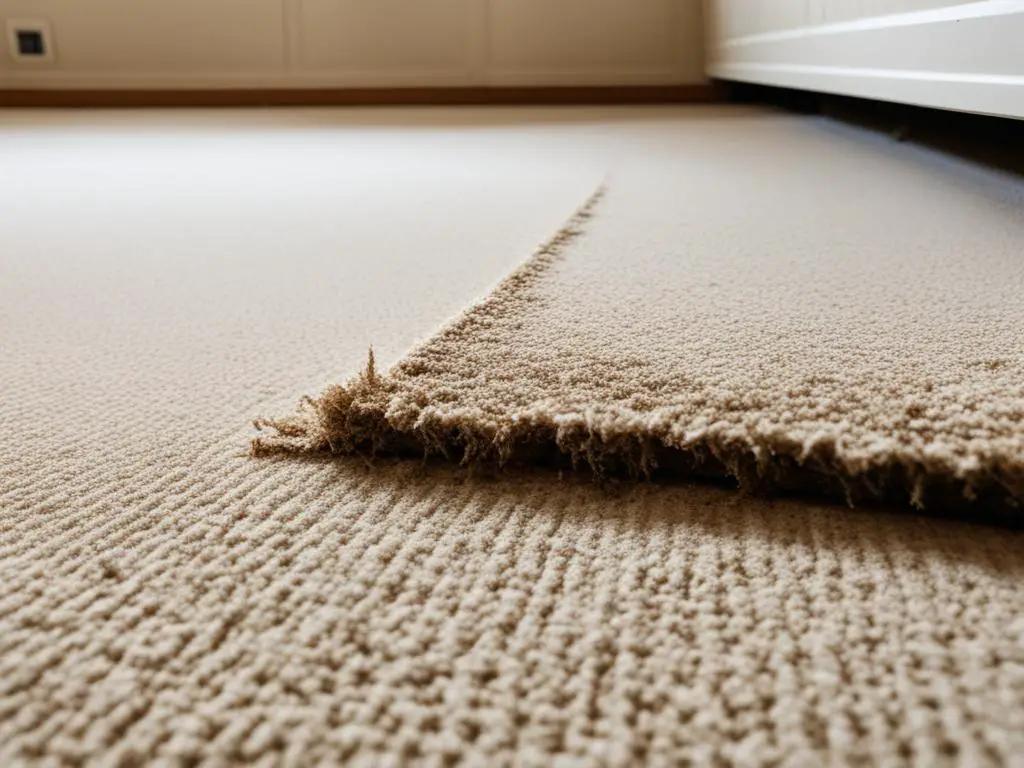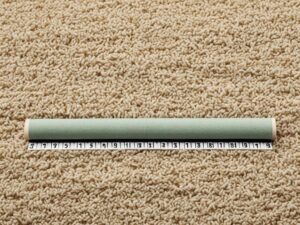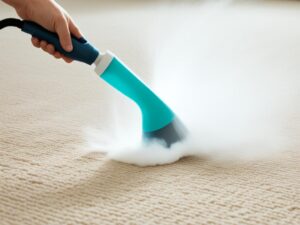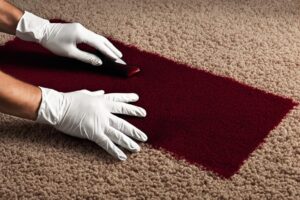In a mobile home, the carpet is just the surface layer. There are several layers beneath it that play important roles in providing comfort, insulation, and support. These layers include carpet padding, subflooring, underlayment, joists, and insulation. Each layer serves a specific purpose, from absorbing impact to providing stability. Understanding what lies beneath your mobile home carpet can help you make informed decisions about flooring options and renovations.
Key Takeaways:
- The layers beneath the carpet in a mobile home include carpet padding, subflooring, underlayment, joists, and insulation.
- Carpet padding absorbs impact and protects the carpet, while the subfloor provides support.
- Underlayment can provide extra cushioning and act as a moisture barrier.
- Joists support the subfloor and insulation, which helps regulate temperature and reduce energy costs.
- Understanding the layers beneath your mobile home carpet can aid in making decisions about replacements and renovations.
The Layers Beneath the Carpet
In a mobile home, the carpet is not the only layer you walk on. There are several important layers that provide comfort, support, and insulation beneath the carpet. Let’s explore each layer in detail:
1. Carpet Padding
Carpet padding is a crucial layer that lies between the carpet and the subfloor. It is typically made from foam or rubber materials and serves multiple purposes. The primary function of carpet padding is to absorb impact, making your carpet more comfortable to walk on. It also helps to extend the lifespan of your carpet by providing a cushioned layer that protects it from wear and tear.
2. Subfloor
The subfloor is the sturdy foundation beneath the carpet padding. It is typically made of plywood or particleboard and plays a vital role in supporting the weight of the mobile home. The subfloor provides a solid surface for installing the carpet and ensures stability throughout the structure.
3. Underlayment
Some mobile homes have an underlayment layer between the subfloor and the carpet padding. The underlayment serves two main purposes. Firstly, it provides additional cushioning and support, enhancing the comfort of the carpet. Secondly, it acts as a moisture barrier, protecting the carpet from any potential water damage.
4. Joists
Joists are horizontal beams that support the subfloor and play a crucial role in the structural integrity of the mobile home. These beams distribute the weight evenly across the subfloor, ensuring stability and preventing sagging or uneven floors.
5. Insulation
Insulation is an essential layer that helps regulate temperature and reduce energy costs in your mobile home. It is typically installed between the joists to provide thermal resistance and prevent heat loss or gain. Insulation also helps to reduce noise transmission between floors, creating a quieter living environment.
Understanding the layers beneath your carpet is important for making informed decisions about flooring options and renovations. Each layer contributes to the overall comfort, support, and insulation of your mobile home, creating a more enjoyable living space.
Now that we have explored the layers beneath the carpet, let’s move on to the signs that indicate it’s time to replace your mobile home carpet.
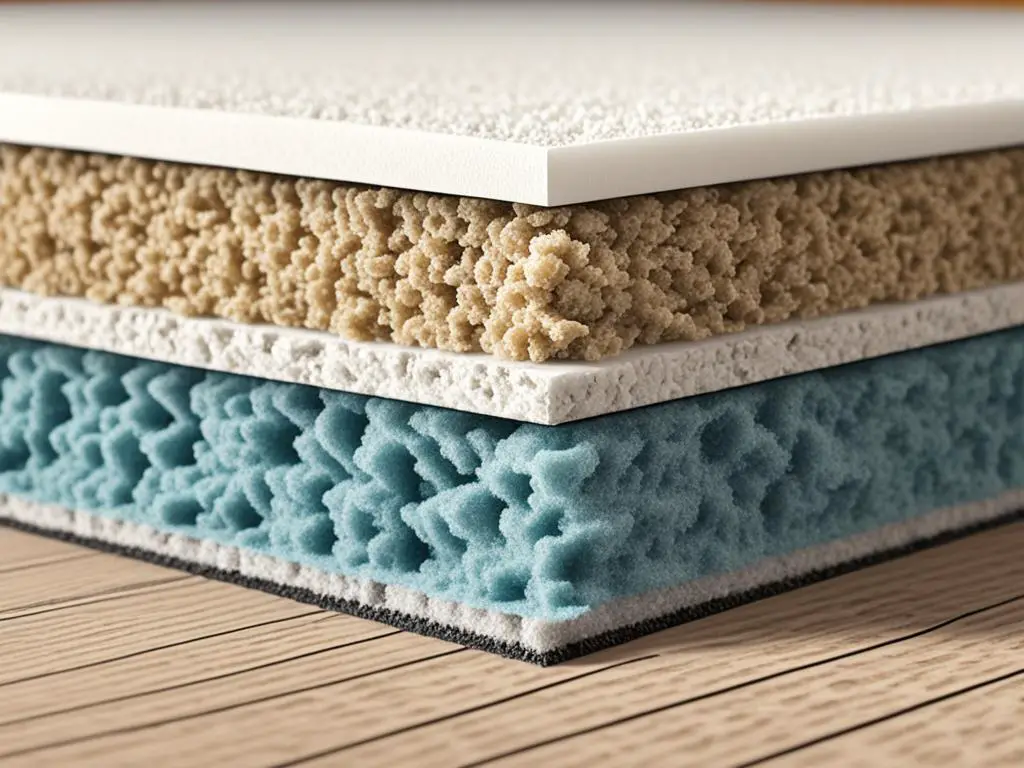
Signs It’s Time to Replace the Carpet
If you’re a mobile home owner, it’s important to pay attention to the condition of your carpet. Over time, carpets can start showing signs of wear and tear due to everyday use and exposure to various factors. Here are some signs that indicate it’s time to consider carpet replacement:
Stubborn Stains
Stubborn stains that have become resistant to cleaning efforts can make your carpet appear dirty and worn out. No matter how hard you try, these stains just won’t budge, leaving your carpet looking stained and unsightly.
Wear and Tear
Carpet in high-traffic areas or heavily used rooms can start to show signs of wear and tear. Fraying edges, matting, and visible signs of damage can make your carpet look old and tired, detracting from the overall appearance of your mobile home.
Odors
Persistent odors in your carpet, especially unpleasant smells that linger despite regular cleaning, can be a sign of deep-seated dirt, mold, or other issues. These odors not only affect the air quality but also create an unpleasant living environment.
Allergies
If you or your family members experience increased allergies or respiratory issues when spending time in your mobile home, it could be due to the allergens trapped in your carpet. Over time, carpets can accumulate dust, pet dander, and other contaminants that can trigger allergies and worsen respiratory conditions.
When these signs start to appear, it’s essential to consider carpet replacement for the health and aesthetic appeal of your mobile home. Installing new carpet will not only improve the overall look of your home but also provide a clean and comfortable living space for you and your family.

How to Replace Carpet in a Mobile Home
If you’re ready to replace the carpet in your mobile home, it’s important to have the right tools and materials for the project. Here are the essential items you’ll need:
- A utility knife for cutting and removing the old carpet
- A carpet stretcher to stretch the new carpet and make it taut
- A knee kicker to secure the carpet along the edges
- A staple gun for attaching the carpet to the subfloor
- A tape measure to ensure accurate measurements
- Carpet adhesive or tack strips, depending on the installation method
- Optional tools: a power stretcher, carpet seam iron, and seam roller for more professional installation
Now that you have the necessary tools and materials, let’s walk through the step-by-step process of replacing the carpet:
Step 1: Remove the old carpet
Start by removing the old carpet and any existing padding. Use a utility knife to cut the carpet into manageable sections, and then roll them up for disposal. Be careful when removing the carpet to avoid damaging the subfloor.
Step 2: Prepare the subfloor
Inspect the subfloor for any damage or uneven areas. Repair or replace any damaged sections as needed. Clean the subfloor thoroughly to remove any debris or glue residue from the previous carpet installation.
Step 3: Install new carpet padding
Measure the dimensions of the room and cut the carpet padding accordingly. Lay the padding over the subfloor, making sure it fits snugly against the walls. Trim any excess padding with a utility knife.
Step 4: Lay down the new carpet
Roll out the new carpet over the padding, leaving a few inches of excess on each side. Use a knee kicker to secure the carpet along the walls, stretching it tightly to remove any wrinkles or sagging. Use a staple gun or adhesive to attach the carpet to the subfloor along the edges.
Step 5: Trim and finish
Trim off the excess carpet using a utility knife and tuck the edges neatly against the baseboards. If necessary, use a carpet seam iron to join multiple sections of carpet together. Finally, use a seam roller to ensure a smooth and seamless finish.
Congratulations! You have successfully replaced the carpet in your mobile home. Enjoy your fresh new flooring!
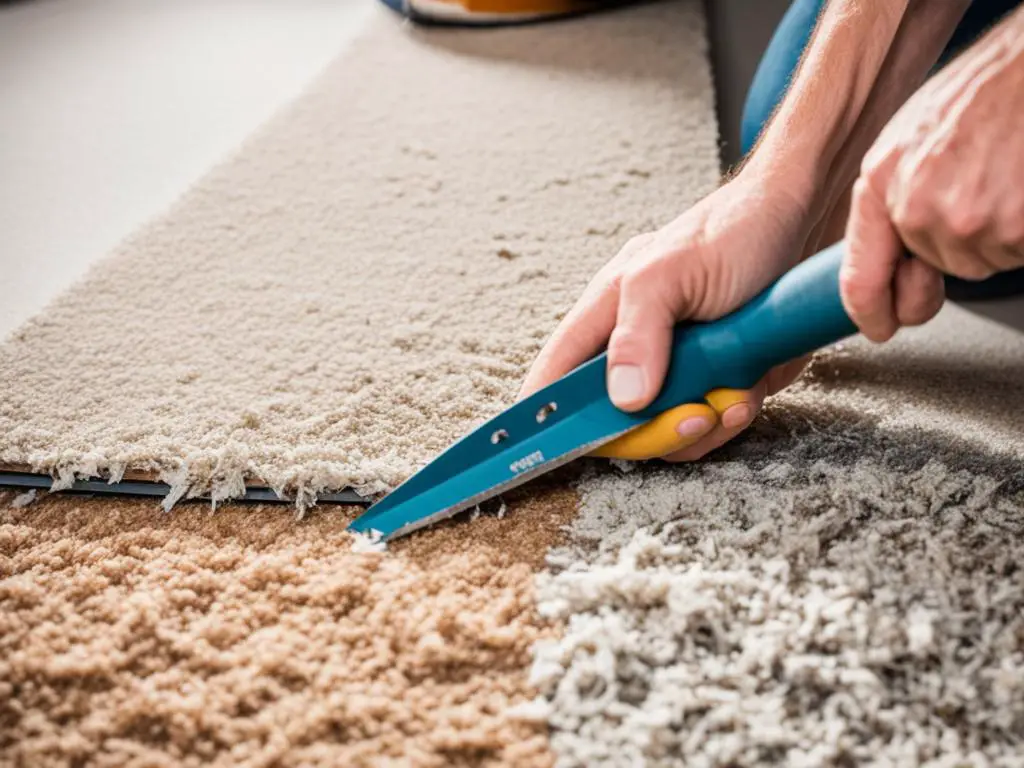
Flooring Options for Mobile Homes
When it comes to mobile home flooring options, there are a variety of choices available to suit your needs and preferences. From vinyl to carpet, hardwood to laminate, each flooring type offers its own unique advantages and considerations.
Vinyl Flooring
Vinyl flooring is a popular choice for mobile homes, particularly in wet areas like kitchens and bathrooms. It is water-resistant, durable, and easy to clean. Vinyl flooring comes in a wide range of colors, patterns, and textures, allowing you to achieve the desired aesthetic for your mobile home interior.
Carpet Flooring
Carpet flooring provides a soft and comfortable surface to walk on, making it a cozy option for mobile homes. It offers excellent insulation, which can help keep your home warm and reduce energy costs. However, carpet requires regular maintenance to keep it clean and may not be ideal for high-traffic areas.
Hardwood Flooring
If you’re looking for a more upscale and timeless flooring option, hardwood might be the choice for you. Hardwood flooring adds elegance and sophistication to any mobile home interior. It is durable and can last for years with proper care and maintenance. However, hardwood flooring can be more expensive and susceptible to damage from moisture.
Laminate Flooring
Laminate flooring is a versatile and cost-effective option for mobile homes. It mimics the appearance of hardwood, tile, or stone flooring at a fraction of the cost. Laminate is easy to install and maintain, making it a popular choice for DIY enthusiasts. However, it may not offer the same level of durability and longevity as hardwood or vinyl.
When choosing the best flooring option for your mobile home, consider factors such as durability, maintenance requirements, and cost. It’s also important to assess the specific needs of each room and the overall aesthetic you want to achieve. Exploring different flooring options will help you find the perfect match for your mobile home.
Pros and Cons of Carpet in Mobile Homes
Carpet in mobile homes offers several benefits, making it a popular choice for homeowners. Let’s take a closer look at the pros and cons of carpet as a flooring option for mobile homes.
Pros of Carpet in Mobile Homes
- Comfort: Carpet provides a soft and cushioned surface to walk on, adding a cozy and warm feel to your mobile home.
- Insulation: One of the major advantages of carpet is its ability to provide insulation. It helps to retain heat in colder months, making your home more energy-efficient.
- Noise Reduction: Carpet absorbs sound, reducing noise levels and creating a quieter living environment.
With these benefits, carpet can enhance the overall comfort and livability of your mobile home.
Cons of Carpet in Mobile Homes
- Maintenance: Carpet requires regular maintenance to keep it clean and in good condition. Regular vacuuming and occasional deep cleaning are necessary to prevent dirt buildup and maintain its appearance.
- Allergens and Dust: Carpet can trap allergens like dust, pet dander, and pollen. This can be a concern for individuals with allergies or respiratory conditions.
- High-Traffic Areas and Pets: Carpet may not be the best choice for high-traffic areas or homes with pets. It can be more prone to stains, wear, and tear in these situations.
Considering the pros and cons of carpet can help you decide if it’s the right flooring option for your mobile home. Assess your lifestyle, maintenance capabilities, and preferences to make an informed choice that suits your needs.
Comparison of Flooring Options
| Pros | Cons | |
|---|---|---|
| Carpet |
|
|
| Vinyl |
|
|
| Hardwood |
|
|
| Laminate |
|
|
Table: Comparison of Flooring Options for Mobile Homes
Design Tips for Mobile Home Flooring
When it comes to designing the interior of your mobile home, the flooring you choose can have a significant impact on the overall aesthetic appeal of your living space. The right colors, patterns, and textures can elevate the design and create a harmonious atmosphere.
One important consideration is the color selection. In a small mobile home, lighter colors can make the space feel more open and spacious. Opting for light hues like whites, creams, or pastels can create an airy and welcoming environment. On the other hand, if you want to add depth and warmth to your space, darker shades such as deep browns or grays can create a cozy atmosphere.
In addition to color, patterns can add visual interest to your floors. Consider incorporating patterns like stripes, chevron, or geometric designs to bring a sense of energy and movement to your mobile home. If you prefer a more subdued look, a simple pattern like a subtle floral or tile-inspired design can provide a touch of elegance without overwhelming the space.
Texture is another important factor to consider. Different flooring materials offer varying textures, from smooth and sleek to textured and rustic. For example, hardwood flooring provides a smooth and polished surface, while laminate flooring can replicate the texture of natural materials like wood or stone. Think about the look and feel you want to achieve and choose the flooring material accordingly.
“The right combination of colors, patterns, and textures can transform the look and feel of your mobile home, creating a space that reflects your personal style and enhances your everyday living experience.”
When making design choices, it’s essential to consider the durability and maintenance of the flooring material. Mobile homes often experience higher foot traffic, so selecting a flooring option that can withstand daily wear and tear is crucial. Additionally, choose flooring that is easy to clean and maintain, as this will help keep your mobile home looking its best for years to come.
Flooring Ideas for Mobile Homes
If you’re looking for some inspiration, here are a few popular flooring options for mobile homes:
- Vinyl: A versatile and budget-friendly option, vinyl flooring is water-resistant and perfect for areas prone to moisture, such as the kitchen and bathroom.
- Carpet: Soft and comfortable, carpet adds warmth and insulation to your mobile home. It’s ideal for bedrooms or living areas where you want a cozy feel.
- Hardwood: If you prefer a timeless and sophisticated look, hardwood flooring can elevate your mobile home’s interior. It’s durable, elegant, and adds value to your property.
- Laminate: Offering the look of hardwood or natural stone at a more affordable price, laminate flooring is a popular choice. It’s easy to install and maintain, making it a practical option for mobile homes.
Remember, the design of your flooring should align with your personal taste and lifestyle. Take the time to explore different options, envision how they would look in your mobile home, and consider consulting with a professional to help you choose the best flooring option for your mobile home interior design.
Conclusion
The layers beneath the carpet in a mobile home play a crucial role in providing comfort, insulation, and stability. Understanding these layers is essential for maintaining a clean and comfortable living space. When signs of wear and tear or persistent odors appear, it may be time to consider carpet replacement. By exploring different flooring options, you can find the best fit for your mobile home.
While carpet offers comfort and insulation, it also requires regular maintenance and can trap allergens. Considering the pros and cons, along with your lifestyle and preferences, will help you decide if carpet is the right choice for your mobile home. Alternatively, options like vinyl, hardwood, or laminate flooring offer durability and a variety of styles to enhance your home’s design.
When choosing mobile home flooring, it’s important to think about the overall design of your space. Factors such as color, pattern, and texture can create a stylish and inviting interior. Lighter colors can make a small mobile home feel more spacious, while patterns and textures add visual interest. Selecting flooring materials that align with your design preferences and practical needs is the key to transforming the look and feel of your mobile home.
